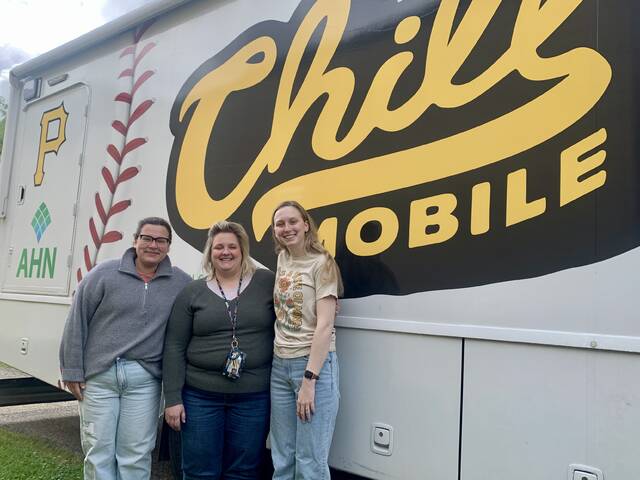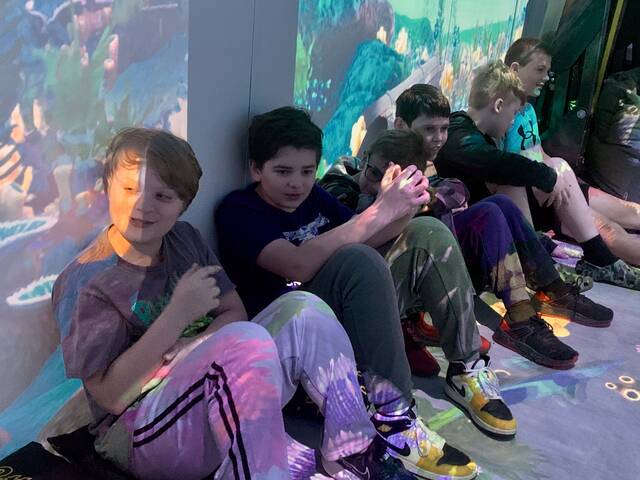Deer Lakes students learn to 'chill' through AHN, Pirates Charities initiative
Everyone needs a minute once in awhile.
Just ask Ana Drum, a Deer Lakes fifth grader learning about mindfulness through a school initiative sponsored by the Allegheny Health Network and Pirates Charities.
The Chill Project, launched in 2019, aims to teach evidence-based coping techniques to students of all grade levels.
A highlight of the program is the Chill Mobile, a roving RV decked out with colorful motion-detected walls and piles of Pirates pillows. It made three stops at East Union Intermediate Center this year with the goal of helping students learn how to relax and relieve anxiety.
“I’ve learned more about my emotions and how to deal with them better,” said Ana, 12. “I can use techniques such as box breathing and counting for, like, 10 seconds to get my mind off of strong emotions.”
Classmate Brayde Austin, 11, said he has learned to identify “stressors” and ways to make them go away.
“For example, I can use my senses to think about a different place, and this gets my mind off of stress,” he said.
AHN officials launched the program to help students, parents and teachers navigate their worries because research shows negative coping skills can be a barrier to learning.
Through the Chill Project, calming spaces and regular instruction help everyone learn to better handle pressure, East Union Principal Jodi VanderSchaaff said.
“This is an additional support for students, and what appeals to me is that it looks completely different,” said VanderSchaaff, principal for five years.
“You have an RV that is painted like a baseball and a space inside with interactive features like walls with swimming fish or floating stars.
“The kids are excited about it.”
The cost to the district was $17,000, paid through a mental health and safety grant from the Pennsylvania Commission on Crime and Delinquency.
Emily Bodo and Karen Cooper, AHN behavioral health school educators, pilot the Chill Mobile through the region and impart age-appropriate lessons on gratitude, acceptance, failure and perseverance.
“We talk a lot about mindfulness and teach the kids to use grounding — taste, smell, hearing, sight and touch — to help them if something is stuck on their minds,” Cooper said.
Program leaders said age-appropriate content is particularly important for preschool children, who might have missed out on in-person learning and engagement during the pandemic.
A study in JAMA Pediatrics showed that young children who were socially isolated during the pandemic were more likely to experience socio-emotional delays than children from a pre-pandemic group.
Challenges could include lack of understanding social cues, difficulty interacting with peers and inability to regulate emotions, according to the study.
For the preteens at East Union, Bodo told them imagination works wonders to manage stress. She encouraged them to describe a magical candy land, with specific instructions geared to transport them away from their current thoughts.
“Imagine what everything is made of,” Bodo told them. “You can’t just say candy. If something looks like a lollipop tree, I want to know what shape it is and what flavor.”
According to AHN, schools participating in the Chill Project have experienced a reduced number of behavioral health incidents for students, such as chronic absenteeism or disruptive behavior, and more access to resources and professional quality of life for teachers and students’ families.
Fifth grade teacher Angela Kozlowski has seen positive impacts from the program.
“The kids are learning tools to be productive in finding self-regulation, and that makes them feel confident,” she said. “It’s a huge resource.”
Through the program, every classroom at East Union gets an ottoman filled with tips and tools to create a Chill Corner. Inside are coloring books, marble mazes and fidget toys.
VanderSchaaff said teachers have the discretion to use the items however they feel will work best.
A longtime teacher in the district before her administrative role, VanderSchaaff believes a key to the Chill Project is that it keeps students in the classroom more. They don’t feel the need to go to the nurse or the bathroom as often when they feel overwhelmed.
“They can step back into the Chill Corner and still hear the lesson but take a few minutes to relax,” she said.
“This makes it socially acceptable that we all need a minute sometimes.”
Tawnya Panizzi is a TribLive reporter. She joined the Trib in 1997. She can be reached at tpanizzi@triblive.com.
Remove the ads from your TribLIVE reading experience but still support the journalists who create the content with TribLIVE Ad-Free.



